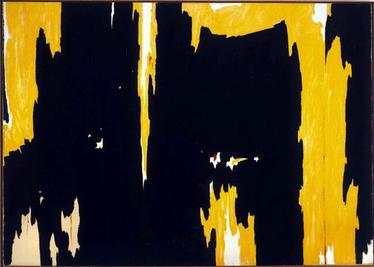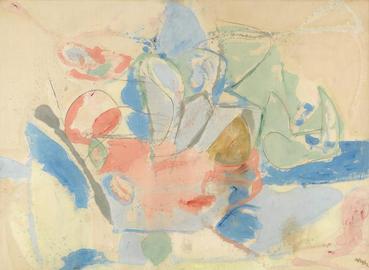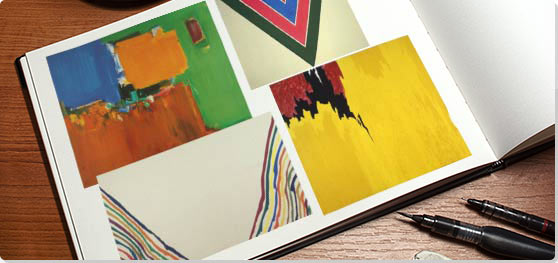Summary of Color Field Painting
Color Field Painting is a tendency within Abstract Expressionism, distinct from gestural abstraction, or Action Painting. It was pioneered in the late 1940s by Mark Rothko, Barnett Newman, and Clyfford Still, who were all independently searching for a style of abstraction that might provide a modern, mythic art and express a yearning for transcendence and the infinite. To achieve this they abandoned all suggestions of figuration and instead exploited the expressive power of color by deploying it in large fields that might envelope the viewer when seen at close quarters. Their work inspired much Post-painterly abstraction, particularly that of Helen Frankenthaler, Morris Louis, Kenneth Noland, and Jules Olitski, though for later color field painters, matters of form tended to be more important than mythic content.
Key Ideas & Accomplishments
- Color Field Painting emerged out of the attempts of several artists in the late 1940s to devise a modern, mythic art. Seeking to connect with the primordial emotions locked in ancient myths, rather than the symbols themselves, they sought a new style that would do away with any suggestion of illustration.
- The style was championed most enthusiastically by critic Clement Greenberg, who acclaimed the advances it achieved in the realm of form and composition. Bemoaning what he saw as the increasingly imitative, academic qualities of some action painters, he argued that Color Field Painting represented the way forward. His advocacy of the style proved highly influential.
- Color Field Painting marks a major development in abstract painting, since it was the first style to resolutely avoid the suggestion of a form or mass standing out against a background. Instead, figure and ground are one, and the space of the picture, conceived as a field, seems to spread out beyond the edges of the canvas.
Overview of Color Field Painting

Saying "A painter is a choreographer of space," Barnett Newman invented what he called the "zip," a band of vertical color. As a result, he added to the Color Field Painting movement a new way to experience space.
Artworks and Artists of Color Field Painting

1957-D-No. 1
There used to be some disagreement over which artist had first arrived at the style of Color Field abstraction. Most now believe that it was Clyfford Still who first did so - and at some remove from those in New York, such as Barnett Newman and Mark Rothko, who were also finding their way to the approach in the late 1940s. In this examplary work Still applied thick portions of color with a palette knife to achieve an effect that evokes a violent sundering in nature. Typically, Still's canvases were covered in rich earthy colors, from edge to edge.
Oil on canvas - Albright-Knox Art Gallery, Buffalo, New York
No. 2, Green, Red and Blue
Although Rothko never considered himself a Color Field painter, his signature approach - balancing large portions of washed colors - matches up to critics' understanding of the style. Rothko considered color to be a mere instrument that served a greater purpose. He believed his fields of color were spiritual planes that could tap into our most basic human emotions. For Rothko, color evoked emotion. Therefore each of Rothko's works was intended to evoke different meanings depending on the viewer. In the time No. 2, Green, Red and Blue was made, Rothko was still using lighter tones, but as more years passed and Rothko's mental health increasingly declined, his Color Fields were constituted by somber blacks, blues, and grays.
Oil on canvas - Private Collection

Mountains and Sea
Helen Frankenthaler played a crucial role in the evolution of Color Field Painting. Some time in or around 1952, Clement Greenberg invited Morris Louis and Kenneth Noland to pay a visit to Frankenthaler's studio in order to witness her technique of staining untreated canvas with paint. This seminal moment marked a turning point for Abstract Expressionism, and soon this new group of artists were simplifying the painting process by applying large bands (or waves, circles, lines, etc.) of uniform color to the canvas, and Color Field Painting advanced further.
Oil and Charcoal on unsized, unprimed canvas - Collection of Helen Frankenthaler Foundation, Inc. (on extended loan to the National Gallery of Art, Washington
East-West
Kenneth Noland is often known for his exacting symmetry. Throughout his career he shifted from targets to chevrons to stripes, and experimented with many other styles in between (most notably the shaped canvas), but he always maintained a visual balance to his work. In East-West, Noland exercised his signature chevron style, and it is one of the many paintings in which the artist sought to achieve effects by marrying colors to simple, geometric forms. As he matured, and his color vocabulary changed, Noland increasingly covered the entirety of his canvases with paint, to the point where his lines and colors seemed infinite, and achieved what Greenberg suggested when he wrote: "capable of repeating the picture beyond its frame into infinity."
Acrylic on canvas - Private Collection
Advance of History
Mark Tobey is one of the lesser-known Abstract Expressionists. Upon first glance, Advance of History almost appears as a tightly wound version of a Pollock "drip" painting. Upon closer inspection, however, an almost decorative pattern emerges that was not prevalent in Pollock's work. Throughout his career, Tobey was renowned for his experimental nature, frequent travel, and fascination with Eastern art and philosophy. As a student of Haiku, Zen, and Japanese calligraphy, among other things, Tobey often took natural forms and elaborate script as his inspiration, and relied on patterns in his paintings as a way of channeling his communion with the natural world.
Gouache and watercolor on paper - The Solomon R. Guggenheim Museum, New York, New York
The Metropolitan Museum of Art 1870-1970
By 1970, Color Field artists like Frank Stella, Kenneth Noland and the late Morris Louis had long established their style as the next phase in modern abstraction. Stella in particular was best known for his Color Field spectrums, in which bands of varying colors were situated in such a way as to render the canvas a three-dimensional field of pure color. What made these paintings unique, and thus a distinctive characteristic of most Color Field work, was the absence of any representation or figurative forms. In Metropolitan Museum of Art 1870-1970, commissioned by the museum for its 100th anniversary, Stella carefully balanced alternating color bands to create a visual plane and framed this plane within a field of primary blue.
Color offset lithograph poster - Fine Arts Museums of San Francisco
Beginnings of Color Field Painting
Rothko, Newman, and Still were all independently moving in the direction of color field abstraction in the late 1940s. Still is generally acknowledged as having achieved it first with a series of paintings he exhibited in 1947, but Newman was also important in making early theoretical contributions to the style. In the same year he organized an exhibition for Betty Parsons Gallery entitled The Ideographic Picture, which gathered together artists such as Mark Rothko, Clyfford Still, and Hans Hofmann, and pointed to the development in recent American art of a "modern counterpart of the primitive art impulse." It was summed up in the concept of the ideograph, which he described - quoting a dictionary - as a "character, symbol or figure which suggests the idea of an object without expressing its name." Newman was searching for an abstract art that might do away with all figurative or quasi-figurative motifs. An abstract form could be a "living thing," he wrote in the exhibition's influential catalogue essay, "a vehicle for an abstract thought-complex." It would be more real and present than a form that was merely abstracted from nature or an object.
The fruitful directions that Newman, Rothko, and Still were traveling in meant that by the late 1940s Abstract Expressionism was starting to split into two divergent tendencies - Color Field Painting and gesture painting. It was not until the 1950s, however, that this formal split was widely recognized by critics.
Color Field Painting: Concepts, Styles, and Trends
Although Still, Rothko, and Newman all developed different understandings of the content of their work, Newman put forth the most well known interpretation in his essay 'The Sublime is Now' (1948). It drew on the 18th century aesthetics of Edmund Burke to put forward a notion that only the sublime was appropriate to a modern age gripped by the terror of war and the threat of the bomb. European art had always striven towards the beautiful, he argued, but it was now time to abandon that search.
Clement Greenberg was perhaps the first to identify and celebrate the emergence of Color Field Painting. He did the most to explore it in his 1955 essay, 'American-Type Painting,' in which he argued that the style advanced a tendency in modern painting to apply color in large areas or 'fields.' He considered this particularly important since it returned to what he saw as one of the most important innovations of the Impressionists - the suppression of value contrasts (contrasts of light and dark hues), to describe depth and volume. Many Abstract Expressionists adopted an "all-over" approach to composition - approaching the canvas as a field, rather than as a window in which to depict figures - but none pushed this as far as the color field painters.
Later Developments - After Color Field Painting
By the late 1950s, a new generation of color field painters was emerging. Inspired in part by the stained abstractions of Helen Frankenthaler, and by Greenberg's criticism, the new group included artists such as Kenneth Noland, Morris Louis, and Jules Olitski. These artists were more formalist in their concerns than the Abstract Expressionists had been, often more unashamedly decorative, and certainly less darkly metaphysical. By pouring oil and acrylic paints onto unprimed canvas, artists such as Frankenthaler allowed their pigments to soak into the canvas rather than to rest on top of it (as was the case with Willem de Kooning, whose paints actually rise up into small mountainous heaps on the canvas). This technique gave their paintings a uniformity of color and a sense of even, flat consistency, as well as a feathery, ephemeral dreaminess.
As the 1960s commenced, artists who Clement Greenberg categorized as Post-painterly abstractionists were among the most prominent color field painters. Morris Louis was creating work that contained a degree of symmetry, rendered by pouring paint in broad bands across the surface of the canvas. Kenneth Noland was painting his bold geometric shapes - targets and chevrons, mostly - and beginning to experiment with shaped canvases. And painters such as Ellsworth Kelly and Al Held were also described as late color field painters, even though their work was also often associated with 'hard edge abstraction.'
Useful Resources on Color Field Painting
- Color as Field: American Painting, 1950-1975Our PickBy Karen Wilkin, Carl Belz
- Colourfield Painting: Minimal, Cool, Hard Edge, Serial and Post-Painterly Abstract Art of the Sixties to the PresentBy Stuart Morris
- The Shape of Color: Excursions in Color Field Art, 1950-2005By Christian Eckart, Mark Cheetham, Sarah Rich, Raphael Rubinstein, Robert Hobbs, David Moos, Polly Apfelbaum, Mary Heilmann, Peter Halley, Matthew Teitelbaum
- Abstract ExpressionismBy Barbara Hess / Introduction to Color Field Painting within the Context of Abstract Expressionism
- Abstract ExpressionismBy Katy Siegel, Lillian Davies, Pauline Pobocha / Comprehensive Overview of the Abstract Expressionist Movement
- Art and CultureBy Clement Greenberg / Includes Clement Greenberg's Major Theoretical Essays, Including 'American-Type Painting' on the Color Field Artists
 Ask The Art Story AI
Ask The Art Story AI





















